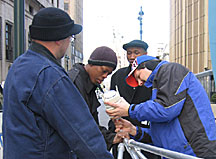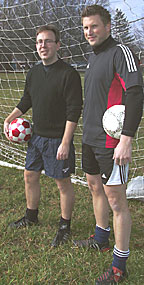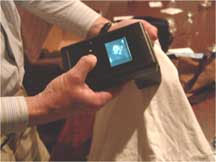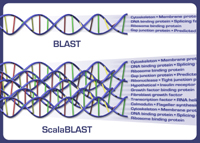| Research
|
DOE's Oak Ridge National Laboratory, which is in the last stages of a building campaign, has provided some valuable real estate for a growing segment of its laboratory population: Soccer players. Soccer, of course, reflects the increasingly international flavor of the research community. Two of ORNL's soccer enthusiasts (or football, as it is known outside the United States ) came to the laboratory as Eugene P. Wigner fellows: Thomas Maier and David Silvermyr. Maier arrived at ORNL in as a postdoc via the University of Cincinnati and Germany . He has since joined the staff's Computer Science and Mathematics Division with an interest in condensed matter theory, more specifically computer simulations of high-temperature superconductors. Silvermyr, a current Wigner fellow, hails from Sweden . He is currently working with the lab's PHENIX detector team for the Relativistic Heavy Ion Collider, searching for the J/psi particle. Maier, the more serious player of the two, participates in a mens' league in nearby Knoxville . "I play the mid-field position. Over here they call it halfback," he says. In Germany Maier played in leagues that feed more rofessional teams with players, similar to American baseball, before stopping because of injuries. But his teams "won the leagues," he says. Silvermyr, a native of Sweden , uses ORNL's new soccer field to take a break from his High Energy Reactions group's research. The soccer field is just outside the Physics Division's offices. "People get together to play three times a week," Silvermyr says. Submitted by DOE's Oak Ridge National Laboratory |
|||||||||||||||||||||||||||
|
See Lawrence Livermore's S&TR magazine.
|
Multiple agencies study
|
 |
|---|
|
Brookhaven scientists worked with students from Medgar Evers College on the Urban Dispersion Program March field study in New York City . |
On a cold, clear morning in early March 2005, a team of approximately 75 scientists, students and federal and local officials gathered at the New Yorker Hotel for a final briefing before heading out into the streets around Madison Square Garden for the first day of a field study on air dispersion in an urban environment.
New York City, with its tall buildings and deep canyons, was an ideal setting for the study, sponsored by the Department of Homeland Security, with additional support from the Defense Threat Reduction Agency of the Department of Defense and the Department of Energy. Data gathered from the study will help improve existing models of how a gas or chemical release might move around Manhattan .
Emergency management, law enforcement and intelligence personnel use these models to plan for, train for and respond to potential terrorist attacks and accidents involving toxic materials. The March field work, coordinated by DOE's Pacific Northwest National Laboratory through the New York City Office of Emergency Management, involved detailed meteorological observations, tracer gas releases, and tracer sampling.
The primary field efforts were accomplished by DOE's Brookhaven National Laboratory, with support from PNNL, the U.S. Environmental Protection Agency, the U.S. National Weather Service, Stony Brook University , Harvard University and Stevens Institute of Technology. The study also offered an opportunity for hands-on training of future engineers and environmental scientists through a partnership with the New York City College of Technology and Medgar Evers College .
Two additional and broader tests, scheduled for later this summer and spring 2006, will add to the team's knowledge of how weather conditions in spring and summer will affect air dispersion. For those broader studies, the collaborator list will grow to include Argonne National Laboratory, Lawrence Berkeley National Laboratory, Lawrence Livermore National Laboratory, two divisions under NOAA Air Resources Laboratory, and the Naval Research Laboratory.Submitted by DOE's Brookhaven National Laboratory



